Autonomous entity
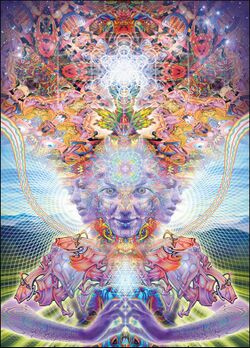
An autonomous entity is defined as the experience of perceived contact with beings which appear to be sentient and autonomous in their behaviour.[1][2][3][4][5][6][7][8] These entities can manifest within both external and internal hallucinations.[7]
Autonomous entities will frequently act as the inhabitants of a perceived independent reality.[6] Although many entities seem largely unaware of a person’s presence they are often precognizant of a person's appearance into their realm and usually choose to interact with them in various ways.
The behaviour of a typical entity can vary wildly and seems to depend heavily on one's current emotional state. For example, while many entities will act as loving beings, teachers, or healers in certain contexts they are equally capable of acting as indifferent, uncaring or even as malicious tormentors.[3][8]
Entities can take any form but subconscious archetypes are present and commonly include:[3][8]
Humans, shadow people, bodiless super intelligent humanoids, aliens, elves, animals, giant spheres, insectoids, beings of light, anthropomorphic beings, plants, conscious inanimate objects, fictional characters, cartoons, robotic machines, gods, demigods, goddesses, bio-mechanical intelligences, hooded figures, demons, indescribable monstrosities, spirits, angels, shamans, ghosts, souls, ancestors, fantastical or mythological beasts, glitch creatures and more.
This experience is often accompanied by other coinciding effects such as geometry,[4] internal hallucinations and delusions. It is most commonly induced under the influence of heavy dosages of hallucinogenic compounds, such as psychedelics, dissociatives, and deliriants. However, it can also occur under the influence of stimulant psychosis, sleep deprivation, and during dreams.
Debate over the existence of autonomous entities
The question of whether these autonomous entities are real or not has often been subject of discussion.
Assuming that our consciousness is formed by a complex and specific arrangement of neural networks, they can be said to be a consequence of the emergent properties of our brain. These perceived entities could be generated by transient changes in brain connectivity induced by certain substances.
For example, an increase in functional connectivity between or inside certain areas of the brain could cause a higher likelihood of the formation of various separated complex structures, which in some cases could be complex enough to be perceived as self-conscious or even have (or give the illusion to have) a higher intelligence than the perceiver.
This would mean that these entities, even though most of the times perceived as separated from our Self, are complex structures emerged by changes in our neural pathways. In a certain way they would be as real as we define ourselves to be (as a "conscious" being), because both our consciousness and the entities are formed by specific complex structures inside the brain. The same argument could be used in many other cases with other kinds of hallucinations and could even lead to the questioning of the definition of reality itself.
Another common hypothesis is that these entities already exist inside our subconscious and/or unconscious and are perceived by the conscious part of the brain due to an abnormal change in connectivity. The presence of certain entities within the unconscious has been widely discussed even in classic psychological literature. For example some of the archetypes hypothesized by Carl Gustav Jung were described as self-conscious entities.
These two hypothesis do not appear to be in conflict with each other, since the presence of innate entities within the psyche and the momentary or permanent formation of others do not exclude each other.
Personality types
There are several distinct personality types of autonomous entity which one may potentially encounter. They are often perceived to represent a particular subsection of a person’s own consciousness and can be identified primarily through their personality, but also their appearance. These individual types are broken down into three separate categories below:
- Representations of general concepts - This personality type can be described as a seemingly sentient representation of any known concept. This will usually adopt an appropriate personality and set of mannerisms to fit the chosen concept with an impressive degree of detail. For example, the specific concept could include other people that the person has met throughout their life, specific fictional characters or symbolic representations of concepts such as abstract ideas, emotions, or key parts of one's own personality.
- Representations of the self - This personality type can be described as a copy of one's own personality. It can take any visible form but when conversed with it clearly adopts an identical vocabulary and set of mannerisms to one's own consciousness.
- Representations of the subconscious - This personality type can be described as an entity which may take any visible form, but is also subjectively perceived to be an autonomous controller behind the continuous generation of the details of the person’s current hallucinations. They may also be felt to simultaneously control or manage one's current perspective, personality, and internally stored model of reality. When interacted with, this category of entity can often possess abilities which allow them to directly alter and manipulate one's current experiences. They commonly want to teach or guide the person and will operate under the assumption that they know what is best for them. However, it cannot be known whether this hallucination is genuinely a representation of the subconscious or is merely an approximation which behaves in a convincing manner.
Communication styles
Autonomous entities can communicate with a person via a combination of spoken word, “telepathy”, conceptual thoughts, mathematics, and geometry-based visual linguistics which generally consists of morphing colored structures of different textures that are innately understandable as representations of specific concepts. They will often convey insights regarding overcoming personal issues within a person’s life and will occasionally help clarify philosophical or spiritual ideas. However, more often than not entities are very likely to speak in a cryptic or nonsensical manner which seems to have no clear meaning behind it.
It is important to note that autonomous entities can never convey novel information to the person experiencing them. For example, they cannot provide insights about the external world which a person did not already know on some level. Instead, they can only provide alternative perspectives and help build upon existing ideas. This is presumably because autonomous entities do not have access to any knowledge which is not already contained within one's conscious or subconscious memories. May contain imprints of genetic memories, access to lifetimes that seem parallel or events that mirror one's connectivity moving past the default mode.
When communicated with through spoken word, the level of coherency in which these entities can communicate with is highly variable but can be broken down into four distinct levels. These are described and listed below:
- Silence - At the lowest level, the effect can be described as a complete unresponsiveness from the entity and a lack of speech despite their presence within the hallucination.
- Partially defined incoherent speech - At this level, the effect can be described as linguistic conversational responses and noises which almost sound like words but do not contain any real content or meaning beyond a vague sense of emotional intent.
- Fully defined incoherent speech - At this level, the effect can be described as audible linguistic conversational responses and noises which contain fully defined and understandable words, but often lack grammatical structure or an overall sense of general coherency.
- Partially defined coherent speech - At this level, the effect can be described as linguistic conversational responses which contain fully defined and understandable words with a partially defined grammatical structure and general coherency. It conveys its point on a level which is frequently coherent, but may not always be fully understandable and will sometimes descend into broken English or even gibberish.
- Fully defined coherent speech - At the highest level, the effect can be described as linguistic conversational responses which contain understandable words and fully defined grammatical sentence structures. It has an overall sense of general coherency which conveys its point in a level of detail that is genuinely on par with that of a person’s own intellect.
Image examples
| Caption | |
|---|---|
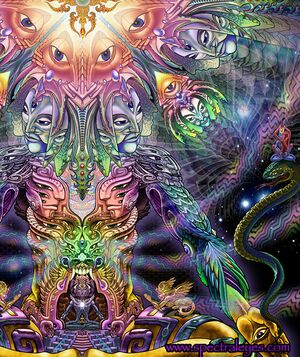 | Alpha Centauri by Luke Brown |
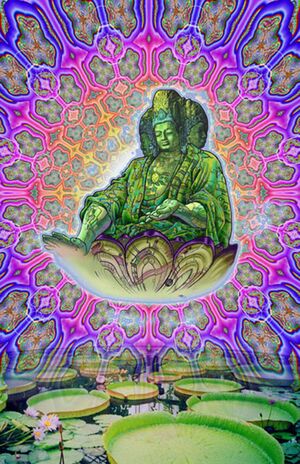 | Maitreya by Luke Brown |
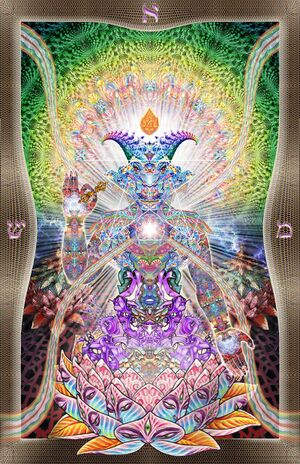 | Baphomet by Luke Brown |
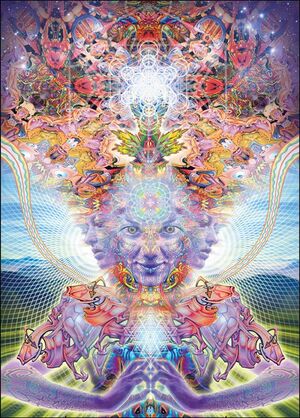 | Namaste (Trifoliata Mystica) by Luke Brown |
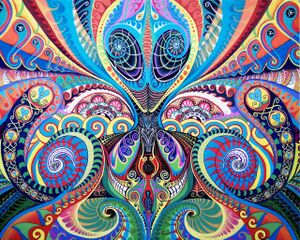 | Untitled by Anonymous |
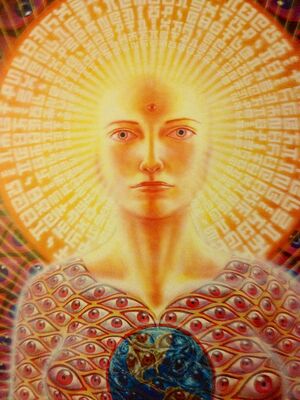 | Sophia by Alex Grey |
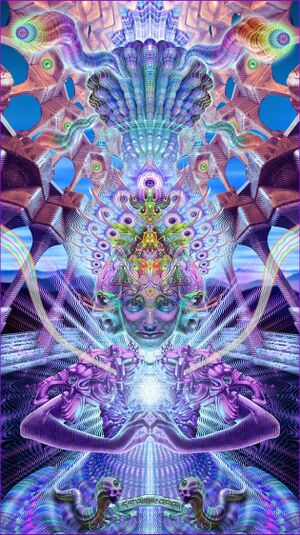 | Apotheosis by Luke Brown |
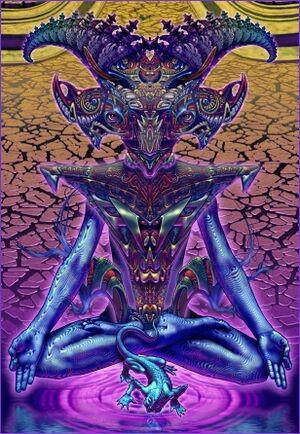 | Jerrestrial detail by Luke Brown |
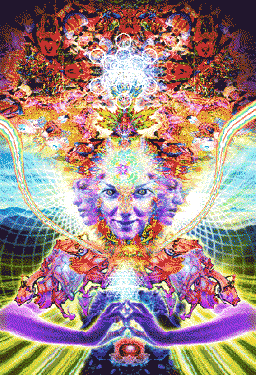 | Namaste 3D by Luke Brown |
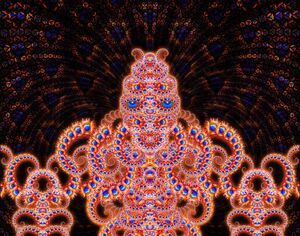 | Id-Aliunde by Beau Deeley |
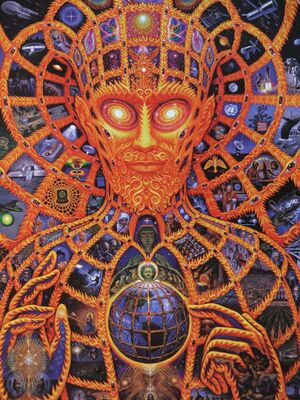 | Cosmic Christ by Alex Grey |
Variations
The specific differences between each potential style of autonomous entity can be broken down into the following variations:
- Lucid vs. Delirious - Autonomous entities can maintain a consistent level of awareness throughout their presence regarding the fact that they are a result of drug-induced hallucination. In contrast to this, entities can also become completely believable in a delusional manner that occurs no matter how absurd or unrealistic their presence may seem.
- Aware vs. Unaware – Autonomous entities can either present themselves as completely unaware of the person's presence in a manner that is similar to watching a video of them play out in front of one's field of vision. However, entities can also be very much aware of the person's presence and will respond accordingly by interacting and conversing with them.
- New entities vs. Memorized entities – Autonomous entities can present themselves as entirely new beings which the person has never experienced before in their day to day or life. However, they can also present themselves as previously known friends, family members, acquaintances, and cultural icons.
- Geometry-based vs. Solid – Autonomous entities can be comprised of condensed psychedelic geometry or they can appear to be made from realistic materials.
Psychoactive substances
Compounds within our psychoactive substance index which may cause this effect include:
- 1B-LSD
- 1P-ETH-LAD
- 1P-LSD
- 1V-LSD
- 1cP-AL-LAD
- 1cP-LSD
- 1cP-MiPLA
- 2-Fluorodeschloroketamine
- 25B-NBOMe
- 25C-NBOMe
- 25D-NBOMe
- 25N-NBOMe
- 2C-B
- 2C-B-FLY
- 2C-C
- 2C-D
- 2C-I
- 2C-P
- 2C-T
- 2C-T-2
- 2C-T-21
- 2C-T-7
- 3-MeO-PCE
- 3C-E
- 3C-P
- 4-AcO-DET
- 4-AcO-DMT
- 4-AcO-MET
- 4-AcO-MiPT
- 4-HO-DET
- 4-HO-DPT
- 4-HO-DiPT
- 4-HO-EPT
- 4-HO-MET
- 4-HO-MPT
- 4-HO-MiPT
- 4-MeO-PCP
- 5-MeO-DiPT
- 5-MeO-MiPT
- 6-APB
- 6-APDB
- AL-LAD
- ALD-52
- Allylescaline
- Amanita muscaria
- Ayahuasca
- Benzydamine
- Bromo-DragonFLY
- DET
- DMT
Experience reports
Anecdotal reports which describe this effect within our experience index include:
- Experience: 25mg 2C-E (oral) - A mindblowing experience
- Experience:1000mg / 1200mg / 1400mg / 1600mg - heroic doses
- Experience:1064mgs - Fascinating DXM experience - Unusual effects
- Experience:150mg MDMA + 20mg 2C-B - I designed it this way myself
- Experience:2 tabs DOB - My DOB Nightmare
- Experience:2.5g Mushrooms + 500mg DMT
- Experience:20mg - I looked up and saw an angry god-like figure made of clouds glaring down at me
- Experience:20x Extract - a tall humanoid figure wearing a white cloak
- Experience:25mg (insufflated) - Simultaneously amazing and horrible
- Experience:25mg DMT - Your wall can't save you
- Experience:26mg - I begged the shroom aliens to kill me
- Experience:2C-P (approx. 35mg) - Asymmetrical Terror and the Geometric Sea
- Experience:3.5g Syrian rue + 50g Mimosa Hostilis - I was trying to engage in sexual intercourse with the personification of Ayahuasca
- Experience:300µg AL-LAD - Don't worry, because you're everyone!
- Experience:30mg (smoked) DMT - The Monolith
- Experience:3g Syrian Rue + 5g Acacia Confusa - Life Changing Madness
- Experience:400mg DXM + 300mg DPH – Bacterial friends
- Experience:40mg (smoked) - The planet became a watermelon
- Experience:40mg DMT - Second breakthrough
- Experience:40x Extract - Bastard Wizard and his miserable little witch
- Experience:50mg - Truth
- Experience:700mg Diphenhydramine trip
- Experience:750mg - Experiencing Void; Dissociation Of Reality And Self
- Experience:DMT (75 mg, smoked) - Bad trip with illustration
- Experience:DMT (unknown dose, smoked) - It felt like I was on rails the whole time
- Experience:DMT (~50mg) + Cannabis - Geometric Angels
- Experience:DMT: 200mg 1/5 changa - Bad yet glorious trip
- Experience:Sleep paralysis hallucinations
- Experience:Unknown dosage - An omniscient sphere
- Experience:Unknown dosage / 1 tab DOC - Psychedelia Turned Into Stimulant Psychosis
See also
- Dream characters
- Sleep deprivation
- Shadow people
- Sleep paralysis
- Stimulant psychosis
- Responsible use
- Subjective effects index
- Psychedelics - Subjective effects
- Deliriants - Subjective effects
- Dissociatives - Subjective effects
External links
References
- ↑ Hirshfeld-Flores, Alissa (2002). "DMT: The Spirit Molecule: A Doctor's Revolutionary Research Into the Biology of Near-Death and Mystical Experiences". American Journal of Psychiatry. 159 (8): 1448–1449. doi:10.1176/appi.ajp.159.8.1448. ISSN 0002-953X.
- ↑ Luke, D. (1 January 2012). "Psychoactive Substances and Paranormal Phenomena: A Comprehensive Review". International Journal of Transpersonal Studies. 31 (1): 97–156. doi:10.24972/ijts.2012.31.1.97.
- ↑ 3.0 3.1 3.2 Luke, D. (January 2011). "Discarnate entities and dimethyltryptamine (DMT): Psychopharmacology, phenomenology and ontology". Journal of the Society for Psychical Research. 75 (1): 26–42. ISSN 0037-9751.
- ↑ 4.0 4.1 Erowid DMT Vault : Apparent Communication with Discarnate Entities, by Peter Meyer
- ↑ Cott, C., Rock, A. "Phenomenology of N,N-Dimethyltryptamine use: a thematic analysis" (PDF). Journal of Scientific Exploration. 22: 359–370.
- ↑ 6.0 6.1 Metzner, Ralph (1998). "Hallucinogenic Drugs and Plants in Psychotherapy and Shamanism". Journal of Psychoactive Drugs. 30 (4): 333–341. doi:10.1080/02791072.1998.10399709. ISSN 0279-1072.
- ↑ 7.0 7.1 Shanon, B. (1 February 2002). "Ayahuasca visualizations a structural typology". Journal of Consciousness Studies. 9 (2): 3–30.
- ↑ 8.0 8.1 8.2 Strassman, R. (1 December 2000). DMT: The Spirit Molecule: A Doctor’s Revolutionary Research into the Biology of Near-Death and Mystical Experiences. Simon and Schuster. ISBN 9781594779732.